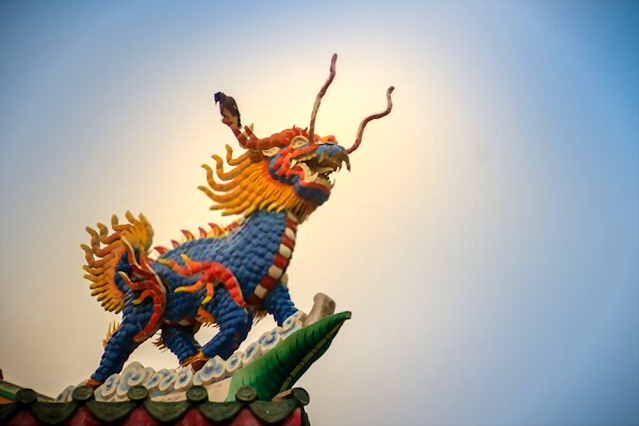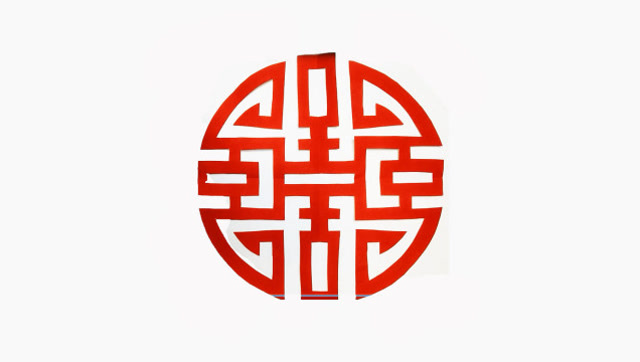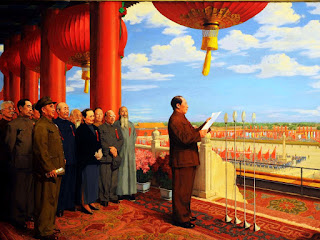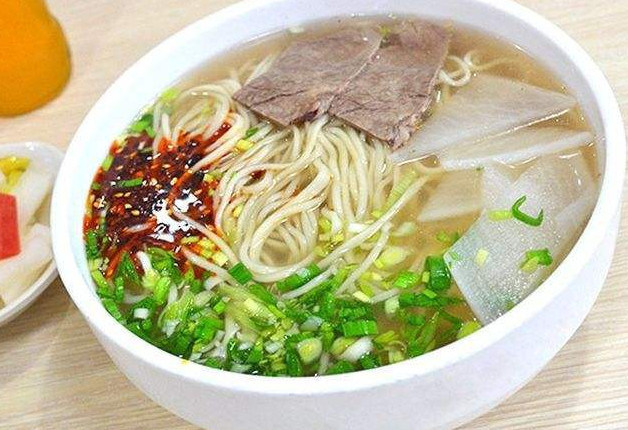23 Unique Chinese Lucky Symbols
The lucky symbols are an indispensable element in China. People rest their hope and expectations on many auspicious symbols. It's estimated that there are hundreds of lucky symbols in China, including characters, patterns, animals, divine deities, numbers, and others.
Four Divine Animals
- 1.Qilin
Qilin is an imagery animal with a deer body, an oxtail, four hoofs, and fish scales. It's the legendary beast of benevolence. It is gentle and courageous, but it never hurt people and property. Some people even regard Qilin as Confucius in animals. According to Chinese folklore, a Qilin descent to Confucius' home when he was born and predicted that Confucius would be a golden boy. Therefore, Qilin symbolizes talented persons.
 |
| Qilin |
- 2.Phoenix
Phoenix is the King of Birds in Chinese culture. It’s a virtual animal with a rooster head, a swallow jaw, a snake neck, a turtle back, a fishtail, and a body of colorful feathers. It’s a symbol of auspiciousness and harmony. Since the Qin dynasty (221 - 207.c), the phoenix became an exclusive symbol of royal females, especially the empresses.
 |
| Phoenix |
- 3.Dragon
Dragon is the totem of the Chinese nationality, representing power and authority. Unlike the ferocious western dragon, the Chinese dragon is an auspicious animal. It has a snake body, a pig head, deer antlers, ox ears, goat beard, eagle claws, and fish scales. Since the Qin dynasty, dragon gradually became the exclusive symbol of emperors.
 |
| Dragon |
- 4.Turtle
Turtle is the symbol of longevity in Chinese culture. It is the longest-lived animal and one of the most endurable animals. Therefore, turtle often appears in calligraphy works and paintings together with cranes. Besides, since ancient times, the turtle is considered an intelligent animal that predicts good and bad luck. Whenever there was a significant decision to make, a piece of tortoiseshell was burnt to foretell the future. In addition, the Chinese legend believed that the goddess Nv Wa used turtle's legs to stabilize the universe.
 |
| Turtle |
Lucky Animals
Many animals are given auspicious meaning by Chinese people, including birds, beasts, sea animals, insects, and more. Besides the four divine animals mentioned before, there are lion, Pi Xiu, crane, elephant, toad, bat, and fish.
- 5.Lion
The lion is the king of beasts and the symbol of authority and responsibility in Chinese culture. However, the lion is rather a divine animal than a regular creature in Chinese mythology. It’s said that the lion was imported from other countries in the Eastern Han dynasty (25 -220) and was given some kind of extraordinary power by the Buddhists. Later, Chinese people make stone lions as guards. It’s common to see a pair of stone lions sitting in front of palaces, temples, pagodas, bridges, residences, gardens, and tombs.
 |
| Stone Lion |
- 6.Pi Xiu
It’s also a legendary beast that doesn’t have an anal opening. It’s said that Pi Xu has a mouth that can eat anything, but its favorite staples are golds, silvers, and jewelry. Therefore, it’s a divine beast of inviting wealth.
 |
| Pi Xiu |
- 7.Crane
As a symbol of longevity, luck, and grace, the crane is often related to deities that enjoy eternal life. Meanwhile, the crane was also considered the first-class bird in Chinese history. During the Ming (1368 - 1644) and Qing dynasty (1644 - 1911), the crane pattern was embroidered on the highest-ranked official's robe.
 |
| Crane |
- 8.Elephant
The pronunciation of the elephant, Xiang, is similar to that of 祥(luck), making the elephant a symbol of luck and peace.
 |
| Jade Elephant |
- 9.Toad
According to Chinese legend, the toad was skilled at disgorging treasures, but it was mischievous and often hurt people. Later, a Taoist master subdued it and forcing it to make money for people. Therefore, the toad statue is the symbol of wealth.
 |
| Golden Toad |
- 10.Bat
Bat is pronounced Fu in the Chinese language, which is the same as 福. Therefore, bat patterns and images are used in all kinds of wares as a symbol of felicity.
 |
| Bat Pattern |
- 11.Fish
Fish has the same pronunciation as 余 (affluence). It’s a must-have dish in the reunion dinner on the evening of the Chinese New Year, symbolizing that there is much wealth left for the next year.
 |
| Fish Pattern |
- 12.Mandarin Duck
Mandarin duck is a kind of waterbird that often appear in couples. The male bird is on the left, and the female bird is on the right. Chinese people relate the couples in love with the mandarin ducks. Therefore, mandarin ducks are the symbol of faithful love.
 |
| Mandarin Duck |
Auspicious Plants
- 13.Plum Blossom
As a traditionally famous flower, plum blossom is not only praised for elegant demeanor in winter but revered for its noble, strong, and modest characteristics.
 |
| Plum Blossom |
- 14.Bamboo
Chinese scholars greatly admire that bamboo could grow in winter and continue to break through the joints. It’s steadfast, ambitious, modest, and always moving upward.
 |
| Bamboo |
- 15.Pine
Pine is an evergreen tree with strong bioenergy. It’s praised for its strong will and unyielding integrity. In traditional Chinese decoration, pine is a symbol of longevity.
 |
| Pine |
Lucky Characters
- 16.福
The first and most important lucky character is “福 (happiness)." It's the eternal theme and goal for all human beings. China has a rich “福” culture. It’s never wrong to give somebody a toast about “福” on festive occasions.
 |
| 福 |
- 17.囍
It’s not exactly a character, but an auspicious pattern people created to express double happiness. The patterns of 囍 are mostly used on wedding days.
 |
| 囍 |
- 18.寿
It’s a character meaning longevity. Therefore, it’s mostly used on people’s birthday, especially for older people.
 |
| 寿 |
- 19.卍
As the oldest lucky character, “卍” is a foreign word from ancient India, Persia, and Greece. It used to be a religious symbol of the sun or flame. With Buddhism being introduced into China, the sign began to be popular among Chinese people. However, the meaning has changed from perfect virtue to happiness and luck.
 |
| 卍 |
Other Lucky Symbols
- 20.Chinese Knot
The history of the Chinese knot can be traced back to primitive people who used ropes to keep records of events. When the written characters were invented to replace the rope in recording, the rope became a vital decoration. Besides, the pronunciation of rope in Chinese is very similar to Sheng (神, god), and the shape of rope resembles a crouching dragon. Therefore, old Chinese people had high regard for strings. They tied ropes on all sorts of things, like jades, coins, miniature Buddha statues, and pouches. Chinese knots in different shapes have various meanings, but the general intention of a Chinese knot is auspiciousness and happiness.
 |
| Chinese Knot |
- 21.Auspicious Clouds
In the agricultural society, clouds are revered as they can make rain to nourish crops. Cloud patterns are created to express people's good wishes of being blessed and good harvest. Besides, clouds are beautiful and free to float. In Chinese mythology, clouds can take deities anywhere. Out of respect and admiration to deities, people extend appreciation and reverence to clouds too. In addition, the cloud in Chinese has the same pronunciation of 运 (luck). Therefore, clouds are also symbols of good luck.
 |
| Cloud Pattern |
- 22.Ruyi
In ancient China, Ruyi was just a back scratcher. It’s a tool that can reach the places where hands can’t go. Therefore, it’s named Ruyi (do something as one wishes). By the Qing dynasty (1644 - 1911), Ruyi completely lost its initial meaning and became a court luxury. Emperors used it as a gift or reward for ambassadors and their ministers.
 |
| Ruyi |
- 23.Longevity Lock
In many places in China, newly born babies are gifted with longevity lock or bracelets made of silvers when they are 100 days old. Chinese people believe that babies with such accessories will live long and safe. Besides, silver itself is effective in prelibation and sterilization. Therefore, small children often wear silver longevity lock or bracelets until they turn 12.
 |
| Longevity Lock |
Related Articles
Chinese Dragons - Origin Connotations Types Decorations and Idioms



Comments
Post a Comment